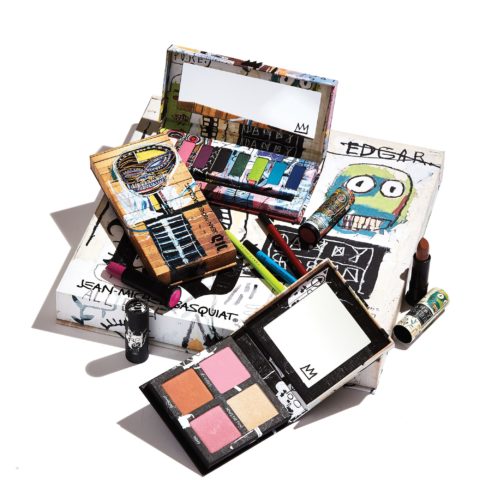Urban Decay’s Jean-Michel Basquiat Collection is Literally a Work of Art
Wende Zomnir had just watched Basquiat, the 1996 film about the life of Neo-Expressionist artist Jean-Michel Basquiat, and was “feeling super-inspired,” when his estate contacted her to do a collaboration with Urban Decay. They were looking for a way to keep Basquiat—who died from an overdose at the age of 27 in 1988—in the pop cultural conversation, and they felt Urban Decay’s edginess was a fit. “We were really flattered,” says Zomnir, co-founder of the brand, wearing a black leather motorcycle jacket with Basquiat imagery scrawled on it and a maxi-dress printed with the artist’s Ascent piece. “I’ve been a fan for so long,” she says.
Growing up in the ’80s, Zomnir had been exposed to Basquiat’s work, but it wasn’t until she took an art history class in college that she began to see his influence. “At that point, his artwork was starting to trickle into general graphic design of the early ’90s,” she says. “It was so important and groundbreaking.” Beyond Basquiat’s artistic style, Zomnir appreciates the social commentary woven throughout his pieces. “A lot of what he paints is about these dichotomies of wealth and poverty and how they intersect,” she says. Zomnir believes that these oppositions are what make Basquiat’s work and Urban Decay align. “We’ve always talked about that intersection between being a strong feminist woman and being beautiful—why do you have to choose?” she says. “There’s that same sort of conflict for us—that we want it all.”
Though the brand’s past collaborations, such as the ones with Disney films Alice Through the Looking Glass and Oz the Great and Powerful, need no introduction, the fact that Basquiat flies much lower under the radar was never a concern. “I thought [his art] was a cool thing to introduce our customer to,” says Zomnir. “And I knew I could make some really cool makeup out of it.” In addition to pulling colours from his paintings and turning them into two eyeshadow palettes, Zomnir used canvas instead of cardboard for much of the collection’s packaging. “It was the right way to reproduce the artwork to make it feel real,” she says. Each palette has a small cut-out on the back, should you want to hang it. Zomnir may just do that, since she doesn’t own an original Basquiat herself. (“I do not—COME ON!” she says, when asked.) She holds up the three palettes, illustrating how they’d look grouped on a wall. “I mean, if you had a small space, how rad would that look?”








